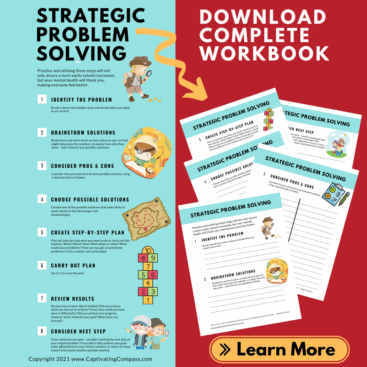Table of Contents
8 steps for Strategic Problem-Solving in Your Homeschool

Teach Critical thinking with the decision-making and problem-solving worksheet pack
Everyone needs help learning decision-making skills and how to problem-solve. It’s not just a math skill, is it?!? It’s a life skill. Using the steps in the Strategic Problem Solving Worksheet pack will help your family master the art of problem-solving for many of life’s challenging situations. So what are we waiting for? Let’s get started!
Step 1: Identify The Problem
Younger students may need help with this step, but middle school students and higher should be able to exercise the problem-solving skills needed in this first step.
Break your problem down into smaller steps and decide what you need to act on first. Before you define a problem, it might feel vague or confusing. Writing out your problem will help to:
- organize information,
- see it from a new perspective, and
- identify the most important issues.
You will want to answer these questions:
- When and where does the problem occur?
- What are the causes of the problem? Think about all the possible causes. Consider your own behavior as well as external factors.
- Define your problem. Be as clear and comprehensive as possible. If there are many parts to the problem, describe each of them.
Life Skill Tip: If you are finding it difficult to separate your emotions from the problem, try to complete this step from the perspective of an impartial friend or small group. Emotional learning is a process, hang in there.
Step 2: Brainstorm
Brainstorm and write down as many ideas as you can that might help solve the problem, no matter how silly they seem – don’t dismiss any possible solutions.
Write down at least three solutions as part of your strategic problem-solving strategy. Without thinking about alternative solutions we often get stuck on what worked in the past or the first idea that comes to mind. There are usually many solutions to a problem, and our first idea isn’t always the best.
Step 3: Consider The Pros And Cons
Consider the pros and cons of each possible solution. You might need extra paper for this! For each possible solution list the pros and cons. This will help you see the problem from various angles and choose the best possible solution. The best decisions are realized when you are able to see both sides of the problem and the possible options for each.
Step 4: Choose Possible Solutions
Begin by throwing out any solutions that are obviously ineffective or impractical. Next, look at your remaining solutions and determine which ones are the most likely to be successful by examining them in-depth. This can be done by examining the strengths and weaknesses of each solution.
Oftentimes, you will come up with new solutions during this stage. You might even find that a combination of multiple solutions is better than any, one idea.
Now, choose one of the possible solutions that look likely to work, based on the advantages and disadvantages.
Life Skill Tip: If you are having a hard time thinking of the advantages and disadvantages of each solution, ask yourself these questions:
- Is this a short-term or a long-term
- How likely am I to follow through with this solution?
- How will this solution affect other people?
The goal here is to use critical thinking to learn how to make good decisions. The problem-solving worksheet pack will help you with every step of the process.
Step 5: Create Step-By-Step Plan
There is so much to consider in this step! To ensure you follow through with your solution, it is best to think of how and when it will be implemented. Without doing so, solutions that are difficult might be avoided, or they can slip your mind when the time comes. Also, make sure you are creating steps that are positive choices that ultimately lead to a responsible decision. The step-by-step decision-making process is also an exercise in self-control and patience for kids, as it requires them to slow down and contemplate the potential consequences of their actions before they actually take them.
Plan out step-by-step what you need to do to carry out the chosen solution. Some solutions can happen at a specific time, like 2:00 pm on Wednesday. Others require something unpredictable to happen, like when I get overwhelmed or angry.
If your solution can be scheduled, you will want to create your step-by-step plan considering these questions
- When will you implement your solution? Be specific.
- How will you remember to follow through with your solution?
- List the specific steps you will take to implement your solution.
If your solution is in response to something, you will want to create your step-by-step plan considering these ideas:
- How will you know when to use your solution? List specific warning signs, triggers, or other specific events that will tip you off.
- List the specific steps you will take to implement your solution.
Finally, you want to also consider these questions as you finish up your step-by-step strategic problem-solving plan.
- Do you see any other way you can get around those problems?
- Is this a realistic and achievable plan?
Life Skill Tip: If your solution requires a lot of time or effort, try to break the process into small steps. It’s easier to follow through with several small steps, rather than one giant task.
Step 6: Carry Out Your Plan
Do it! Carry out the plan. If it is helpful and isn’t too awkward, have your list of steps with you so you remember what to do. Take a deep breath and implement your strategic problem-solving plan! You got this!
Step 7: Review Results
Finally, after implementing your solution, you will review what worked and what didn’t. Answer these questions:
- Was it helpful?
- Did you achieve what you set out to achieve? If not, how could you have done it differently?
- Did you achieve any progress, however small, towards your goal?
- What have you learned?
Step 8: Consider Your Next Steps
If you achieved your goal – consider tackling the next step of your original problem. If you didn’t fully achieve your goal – make adjustments to your chosen solution, or return to steps 3 and 4 and choose another possible solution.
Even if your problem was a one-time situation, there are often broader lessons to be learned. Take a moment to reflect on your problem and how you handled it. Specifically, answer these questions:
- In what way was your solution effective?
- In what ways was your solution not effective?
- If you could go back in time, what would you change about how you handled the problem?
- What advice would you give to someone else who was dealing with the same problem?
Tackle problems Like A Pro With The Complete Decision-Making and Problem-Solving Worksheet Pack
The Strategic ProblemSolving Worksheet pack includes the PDF version of this blog post and the 6-page worksheet pack to collect all your thoughts and ideas as you solve life’s big and little problems. The complete worksheet pack is helpful for all ages. Younger homeschoolers will need more help processing and brainstorming ideas and solutions, while older students and adults can work independently. However, a good conversation with a trusted friend or family member is always helpful when solving difficult situations.
Get your Decision-Making and Problem-Solving Worksheet Pack Here
If you have a coupon code, use it at checkout.
-
Product on sale
 Strategic Problem Solving WorkbookOriginal price was: $12.00.$7.00Current price is: $7.00.
Strategic Problem Solving WorkbookOriginal price was: $12.00.$7.00Current price is: $7.00.
check it Out! Decision-Making and Problem-Solving Worksheet – FREE Checklist!
You may also enjoy
- Let’s Study Famous Folks – December Calendar

- 75 Positive Affirmations: Printable for your Homeschool

- Let’s Study Famous Folks- November Calendar Of Famous People

- How To Turn Any Homeschool Curriculum Into A Family Travel Adventure.

- Famous Scientists Every Teen Should Know

- The Best Homeschool World History & Geography Curriculum Pairs


